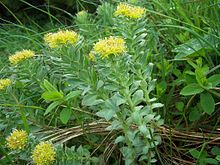| Rhodiola rosea | |
|---|---|

| |
| Scientific classification | |
| Kingdom: | Plantae |
| Clade: | Tracheophytes |
| Clade: | Angiosperms |
| Clade: | Eudicots |
| Order: | Saxifragales |
| Family: | Crassulaceae |
| Genus: | Rhodiola |
| Species: | R. rosea
|
| Binomial name | |
| Rhodiola rosea | |

| |
| Synonyms[1] | |
Rhodiola rosea (commonly golden root, rose root, roseroot,[2]: 138 Aaron's rod, Arctic root, king's crown, lignum rhodium, orpin rose) is a perennial flowering plant in the family Crassulaceae.[3] It grows naturally in wild Arctic regions of Europe (including Britain), Asia, and North America ( N.B., Nfld. and Labrador, N.S., QC.; Alaska, Maine, N.Y., N.C., Pa., Vt),[4] and can be propagated as a groundcover.[3]
Although Rhodiola rosea has been used in traditional medicine, there is no high-quality clinical evidence of its effectiveness to treat any disease.[5][6][7] The United States Food and Drug Administration has issued several warnings to manufacturers of R. rosea dietary supplements for making false health claims about its safety and efficacy.[8][9][10]
The plant is threatened in many countries due to rapidly growing demand.[11] Supply comes mostly from wild harvesting on an industrial scale, and a combination of growing scarcity and a lack of regulation has led to environmental degradation, substitution or adulteration in the market, and illegal harvesting in protected areas.[12]
- ^ Reid V. Moran (2009), "Rhodiola rosea Linnaeus, Sp. Pl. 2: 1035. 1753", Flora of North America online, vol. 8
- ^ Stace, C. A. (2010). New Flora of the British Isles (Third ed.). Cambridge, U.K.: Cambridge University Press. ISBN 9780521707725.
- ^ a b "Rhodiola rosea L." Plants for a Future. 2012. Retrieved 28 February 2017.
- ^ Moran, Reid V, in Flora of North America. volume 8. pages 164-167
- ^ "Rhodiola rosea". Drugs.com. 2019. Retrieved 9 October 2018.
- ^ "Rhodiola". National Center for Complementary and Integrative Health, US National Institutes of Health. September 2016. Retrieved 28 February 2017.
- ^ Cite error: The named reference
Ishaque-2012was invoked but never defined (see the help page). - ^ Cite error: The named reference
fda1was invoked but never defined (see the help page). - ^ Cite error: The named reference
fda2was invoked but never defined (see the help page). - ^ Cite error: The named reference
fda3was invoked but never defined (see the help page). - ^ Xin, T.; Li, X.; Yao, H.; Lin, Y.; Ma, X.; Cheng, R.; Song, J.; Ni, L.; Fan, C.; Chen, S. (2015). "Survey of commercial Rhodiola products revealed species diversity and potential safety issues". Scientific Reports. 5: 8337. Bibcode:2015NatSR...5E8337X. doi:10.1038/srep08337. PMC 4321177. PMID 25661009.
- ^ Brinckmann, J.A.; Cunningham, A.B.; Harter, David E.V. (April 2021). "Running out of time to smell the roseroots: Reviewing threats and trade in wild Rhodiola rosea L". Journal of Ethnopharmacology. 269: 113710. doi:10.1016/j.jep.2020.113710. PMID 33358852. S2CID 229688390.